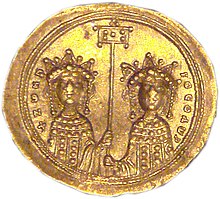Kitaláltuk, hogy mégiscsak elvisszük a szörnyiket a Nemzeti Múzeumba:
Nagyon szépen felújították a magyar őstörténeti kiállítást, és tényleg élvezetes volt. És igen, a legizgalmasabb dolgot a történelmi utazás során találtuk: létezett egy Zoé császárnő, Theodora császárné nővére! És igen, természetesen híres volt ellenállhatatlan szépségéről! Nem is csoda, hogy háromszor is férjhez ment:)
Íme a története:
Zoe Porphyrogenita
From Wikipedia, the free encyclopedia
| Zoe Porphyrogenita | |
|---|---|
| Empress of the Byzantine Empire | |
 | |
| Empress Zoe as depicted in a mosaic from theHagia Sophia | |
| Reign | 19 April 1042- 11 June 1042 |
| Predecessor | Michael V |
| Successor | Constantine IX |
| Reign | 15 November 1028 - 11 April 1034 11 April 1034 - 10 December 1041 11 June 1042 - June 1050 |
| Spouse | Romanos III Michael IV Constantine IX |
| Dynasty | Macedonian |
| Father | Constantine VIII |
| Mother | Helena |
| Born | c. 978 |
| Died | June 1050 (aged 72) |
| Burial | Church of the Holy Apostles ?,Constantinople |
Zoe (in Greek: Ζωή, Zōē, meaning "Life"), (c. 978–June 1050) was Empress of the Byzantine Empire with co-rulers November 15, 1028–1050, and senior reigning Empress from April 19 to June 11, 1042.
[edit]Early life
Zoe was one of the few Byzantine empresses who was Porphyrogenita, or "born into the purple" (that is, as the child of a reigning emperor). She was the daughter of Constantine VIII and Helena, daughter of Alypius. Her father had become co-emperor in 962, and sole emperor in 1025. He reigned for only three years between December 15, 1025 and November 15, 1028.
Worried by the prospect of associating another man with the imperial house, Constantine VIII prevented his daughters from marrying until the very end of his life; however, it was probably Zoe the Byzantine princess who was sent to Italy in order to marry with Otto III, Holy Roman Emperor, but his early death in 1002 prevented the union.[1] Before dying, Constantine had married Zoe to his chosen heir Romanos III Argyros, the prefect (eparch) of Constantinople, on November 12, 1028. By this time, Zoe had reached 50 and had failed to produce any heir. Romanos III succeeded to the throne together with Zoe three days after they married, but this failure helped alienate the couple. Romanos incurred his wife's animosity by paying little attention to her and limiting her spending, while Zoe herself became enamoured of her courtier Michael.
[edit]As an Empress
On April 11, 1034, Romanos III was found dead in his bath, and there was speculation that Zoe and Michael had had him strangled or drowned.[citation needed] Zoe married Michael later the same day, and he reigned as Michael IV until his death in 1041. Although Michael proved to be a more uxorious husband than Romanos, Zoe remained excluded from politics by the monopoly on government enjoyed by Michael's brother John the Eunuch. The disgruntled empress conspired in vain against John in 1037 or 1038.[citation needed]
Shortly before the death of Michael IV in December 1041, the couple adopted as their son Michael V, the son of Michael IV's sister. After several months of rule, the new emperor exiled his adoptive mother to a convent on Principus (one of the Princes' Islands near Constantinople). The population of the city, loyal to Zoe, quickly forced him to recall the empress and her younger sister Theodorain April 1042. The sisters deposed Michael V, blinded him, and exiled him to a monastery, where he died later the same year. For two months, Zoe shared power with Theodora, until she could find yet another husband, her third, and the last she was permitted according to the rules of theOrthodox Church. Her choice was Constantine IX Monomachos (reigned 1042–1055), who outlived her by four years. Zoe died in 1050.[citation needed]
Zoe was fifty when she first married. Despite her age, she married twice more. Ironically, the most capable of her husbands was the one who was least well prepared to be emperor, Michael IV. It is said she was stunningly beautiful, and Michael Psellos in his Chronographia commented that, like a well baked chicken, "every part of her was firm and in good condition." She was aware of her charms and meant to keep and use them for as long as possible. With typical Byzantine ingenuity, she had many rooms in her chambers converted into laboratories for the preparation of secret ointments, and she was able to keep her face free of wrinkles until she was sixty.
[edit]Bibliography
- (primary source) Michael Psellus, Chronographia.
- The Oxford Dictionary of Byzantium, Oxford University Press, 1991.
Zoe Porphyrogenita Born: c. 978 Died: June 1050 | ||
| Regnal titles | ||
|---|---|---|
| Preceded by Michael V | Byzantine Empress 1042 | Succeeded by Constantine IX |
| Royal titles | ||
| Preceded by Helena | Byzantine Empress consort 1028–1041 | Succeeded by Herself |
| Preceded by Herself | Byzantine Empress consort 1042–1050 | Succeeded by Catherine of Bulgaria |






